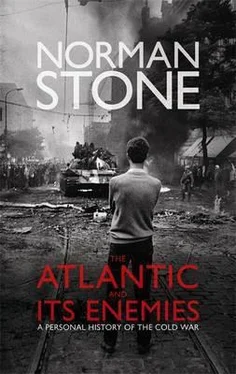These subjects came up on the Rambouillet agenda of the ‘G7’, as they were to be called. By now, ideas of radical change were in the air: otherwise, the Western world would be in thrall to the Arabs, and the Soviet Union, with its vast oil revenues, would predominate. A declaration promising exchange rate stability and restored trade was made; beyond that — a sign of what was to come — the International Monetary Fund was invoked, and at last given a true world role. This was the start of the celebrated formula, the ‘Washington Consensus’, in effect shaped by the USA. It amounted to a recognition that the post-war order, with reference in effect to John Maynard Keynes and Bretton Woods in 1944, had failed. There must be liberalization.
The problem of inflation was worldwide, but it was worst in the Atlantic countries. The USA, after the Nixon crash, was in poor shape and needed the formula itself, as the dollar went down. Newly emerging Far Eastern countries, especially Japan, were making American exports uncompetitive; great heavy industrial regions turned into ‘rust belt’ country, historic places such as Baltimore or Philadelphia becoming wastelands. In the USA and in England, blundering efforts were made even by supposedly right-wing regimes to control wages, but to make this acceptable to trade unions, prices were also controlled, and, with reference to the unions’ supposed interest in equality, ‘the rich’ were to be taxed heavily. In practice, this meant tax rates of 80 per cent at a none-too-high level, and on ‘unearned income’, i.e. people’s savings, 98 per cent. The argument behind this was that inflation was caused by excessive wage demands from trade union leaders who had become spoiled and greedy; they might give up their bad habits provided that the middle classes were taxed so hard that equality would prevail. However, the trade unionists themselves then found that they were being taxed at higher levels: there was even a danger that people who were receiving welfare payments would pay tax at 40 per cent. Improvement did not follow, and in any case the unions could always say, and this was the right thing to say, that their problem was not greed, that prices were rising, that their wage demands were defensive. ‘Corporatism’, English-style, was no more successful than the preposterous ‘Planning’ had been before it. Alternative thoughts were then thought.
There was another argument altogether as to why inflation rose, and it was advanced under the name ‘monetarism’. In 1970 Milton Friedman, an American economist (who had had experience of Cambridge but not in the charmed circle of King’s College: he had stayed at Gonville and Caius, where the leading light was the Budapest-Jewish Peter Bauer), gave a lecture in London to the effect that the British economists were ‘naïve, unsophisticated’ — more so even than the Americans of the 1930s. He noticed later on that ‘the present situation cannot last. It will either degenerate into hyper-inflation and radical change, or institutions will adjust to a situation of chronic inflation; or governments will adopt policies that will produce a low rate of inflation and less government intervention into the fixing of prices.’ There was, said Friedman, an alternative course: to control the supply of money. Inflation was at the source of the whole problem, and that could be stopped if governments stopped producing the paper money (most of that consisting of figures printed in bank accounts) that caused it.
The argument was not really new. Economists had argued as to the role of money for a long time, and in the nineteenth century there had been differences as to whether the supply of money and credit just reflected the demand for it, or whether it shaped that demand. The brightest brains of Europe, the British in the lead, had addressed such questions, and they could only be answered with a good grasp of mathematics, logic and history. In late-nineteenth-century Cambridge, Economics had even arisen out of Moral Sciences, the working name for Philosophy. However, along with moral questions, there were technical ones. What was money? In the nineteenth century the question almost answered itself because money was based on gold, which of course had a value. True, there was not very much gold, but a piece of nobly printed paper could be taken to the bank and changed back, if need be, into so many ounces of gold. Of course that did not happen, because gold was heavy and could be stolen, and if governments were trusted, then their paper was as good as metal — especially in England, where the gold reserve was actually quite small, less than Russia’s. However, there were limits to the amount of paper that could be printed in these circumstances, and that limited bank credits. People who needed them sometimes wanted to have a wider basis for money (in the USA there were demands from farmers for silver to be used as well as gold). Keynes in the 1920s and still more in the 1930s had wanted governments to abandon these standards, on the grounds that gold was ‘a barbarous relic’, that a properly managed paper money would expand credit, stimulate the economy and cause employment to happen. His critics said that a paper money of this sort would mean a rise in prices, the inflation that did indeed occur in the seventies. Friedman was returning to the older ideas of monetary stability: the seventies were to bear out such wisdoms.
At the time these ideas were not at all fashionable. As David Smith says, to be a monetarist in the 1960s was ‘like having an unfortunate but embarrassing affliction which people were too polite to mention’. The grand establishment at King’s, Cambridge, basked in the sunlight of Keynes, and disdained monetarists, who were on the whole of a lower order. They seemed to be backwoodsmen, offering the grim formulae that had made the thirties such a black decade in the minds of the Keynesians, who sneered. As Keynes’s biographer, Robert Skidelsky, has demonstrated, there was even a sexual aspect to this. Keynes broke the rules, did so in a very sophisticated way, and was never held to account for it, even though other homosexuals, including the inventor of the computer and cracker of the German codes in the war, Alan Turing (also of King’s, but not as grand as Keynes), were harried to death because of it. Old E. M. Forster and George ‘Dadie’ Rylands, characteristic of the twenties, lived on and on, into a world where Death in Venice became museum piece Edwardian, and witnessed a radical change: Antonio Gramsci came to King’s, which adopted the causes of 1968, discovered women, and went in for positive discrimination of various sorts. It did not flourish, eventually going bankrupt, bringing down Cambridge Economics with it: within a generation, no foreigner bothered with it, and even very few English graduate students took its doctorates. The then Provost, Noel Annan, wrote memoirs, Our Age (1990), explaining why this course had been adopted, and of course not just at radical King’s alone, but widely across the old institutions, such as the BBC. He recognized the mistake, but the Cambridge economists of that era were part of ‘our age’, and they high-hatted little Friedman, happily married, quite Jewish, and very American. One of the best monetarists, Alan Walters, not of grand social origins, and initially interested in the economics of another British disaster area, transport, was turned down when he wanted support for research in a monetarist direction in the 1960s: the money supply was dismissed as unimportant.
True, there were outposts. The University of Chicago — Friedman’s — was one such, and not just in economics. The USA was still in some ways an old-fashioned country, and Chicago, a place dominated by an Irish-Italian-Polish Catholic mafia much as other religion-mixed cities had been in 1900, was a place where political arithmetic made more sense than the moral algebra of Keynes. Catholic priests were everywhere far more adept than Protestant pastors at mobilizing votes, making non-Catholics pay for municipal jobs and contracts awarded to their followers. ‘Who, whom?’, i.e. who paid for whom, was the great question, and a simple answer to mafias was for money not to be created for them to steal. In 1956 Friedman wrote his article on ‘The Quantity Theory of Money’: it restated the old idea that money did indeed have an independently very powerful role in shaping the economy, and did not just reflect the shape of it. As matters worsened in London, these ideas began to surface. One of Chicago’s professors, Harry Johnson, a heavy-drinking Canadian with verve, also held an appointment at the LSE, and by 1969 influential commentators in London had become interested, particularly Peter Jay at The Times and Samuel Brittan at the Financial Times. All along, there had been people — in the main, disciples of Keynes’s great critic, Friedrich von Hayek — who had not liked the orthodoxies of the Welfare State. They had been derided, but, with support from enlightened businessmen, a successsful poultry farmer set up the Institute of Economic Affairs (IEA), where, in the high noon of Keynesian England, the old ideas were kept alive. The IEA published interestingly, staged provocative lunchtime meetings, and often proved to be right. Now, in the mid-seventies, it began to move centre-stage.
Читать дальше












![Edward Ellis - Adrift on the Pacific - A Boys [sic] Story of the Sea and its Perils](/books/753342/edward-ellis-adrift-on-the-pacific-a-boys-sic-s-thumb.webp)